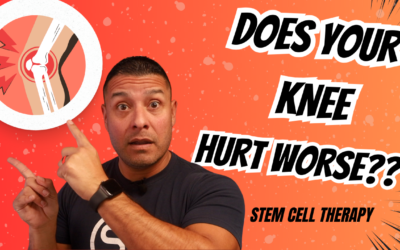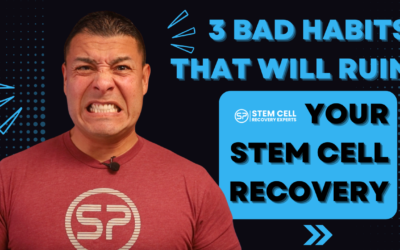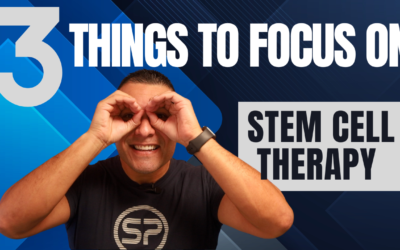“4 Things People Fail to Consider After Stem Cell Therapy”
If you’ve recently had stem cell therapy or are preparing for it, understanding the full picture of recovery can help you maximize your results. After working with hundreds of stem cell patients, Dr. Chris Garcia, a leading expert in stem cell recovery, has identified four critical aspects many patients overlook post-therapy. Let’s dive into these often-missed factors to set you up for a successful recovery journey.
1. The Lengthy Recovery Process
One of the most common misconceptions about stem cell therapy is the recovery timeline. Many patients feel eager to resume activities and underestimate the gradual, structured nature of the healing process. A typical stem cell recovery spans 6 to 12 months, with specific milestones set for each month. By month six, many patients can begin returning to activities they love, whether that’s jiu-jitsu, pickleball, running, or other forms of exercise.
It’s important to recognize that if a second injection is needed, this could extend the recovery period to almost a year. Working with a specialized physical therapist—either locally or through virtual consultations—is essential. A recovery expert can help you navigate this journey, ensuring you stay on track with your milestones and get back to doing what you love without unnecessary setbacks.
2. Work-Life Adjustments
Stem cell therapy is a unique and intensive procedure, and it often requires adjustments to daily routines, particularly if you rely on physical activity for work or personal life. For instance, if you received knee injections, you may not be able to walk or perform other basic tasks for a period of time. This can affect your ability to play with your kids, complete work responsibilities, or even carry out day-to-day activities.
Planning for these limitations in advance can prevent unwanted stress. Ignoring the physical constraints during recovery can lead to flare-ups or complications, which can slow down your progress. Understanding the full impact of your recovery process on both work and personal life will help you plan accordingly, ensuring smoother and faster healing.
3. Fitness Limitations
Many people rely on physical activity not only for fitness but also for mental well-being. If you’re used to hitting the gym, doing yoga, or taking Pilates classes, it can be difficult to accept that these activities might be off-limits for the first few months after therapy. Typically, patients can only begin low-impact exercises around month four, with a return to more intense activities by month five.
Being prepared for these limitations is key to avoiding frustration. Physical inactivity can affect mental health, as exercise often releases feel-good neurotransmitters that help manage stress. Mentally preparing for this pause and considering alternative ways to stay positive during this period can prevent feelings of dissatisfaction and doubt about the therapy’s effectiveness.
4. Mental Preparation for the Recovery Period
The extended recovery can be mentally taxing, particularly for those who are accustomed to active lifestyles. Knowing that you’ll be limited in your physical capabilities for a while can feel restrictive, almost like being in a “mental prison.” Having a recovery specialist by your side can help ease this feeling, guiding you through each stage and keeping your outlook positive.
Mental preparation for this journey is as crucial as the physical process. A stem cell recovery expert can assist you in setting realistic expectations and milestones, helping you avoid feelings of being lost or frustrated. Having a support system in place, along with clear goals, can make a significant difference in your recovery experience.
Setting Yourself Up for Success
To sum it up, being aware of these four areas—recovery process, work-life balance, fitness adjustments, and mental preparation—will give you a strong foundation for a successful stem cell therapy recovery. Proper planning, realistic expectations, and professional support can transform the process, making it smoother and more manageable.
If you have questions about your recovery journey or wonder if you’re on the right track, don’t hesitate to reach out for guidance. Having someone to navigate this with you can be invaluable. Take these steps now to set yourself up for long-lasting results and a healthier future!
Need More Guidance?
For more resources or assistance with your recovery, feel free to contact the Stem Cell Recovery Experts who specialize in stem cell rehabilitation. For more recovery tips and long-lasting results, feel free to call us (619-397-1391). We’re here to help!
If you found these tips helpful, don’t forget to subscribe to our YouTube channel (CLICK HERE) for weekly updates on how to recover safely and effectively after stem cell therapy.
If you’re a visual learner, check out the YouTube video I created on this topic:
Sincerely,
Dr. Chris Garcia, PT, DPT, SCS, CSCS, USAW

“Dr. Chris Garcia is the world-renowned expert on stem cell recovery, internationally recognized public speaker, and trusted advisor to physical therapists globally.”
Why Does My Knee Hurt More After Stem Cell Injections?
"Why Does My Knee Hurt More After Stem Cell Injections?"If you’ve recently had stem cell injections in your knee and are experiencing increased pain and swelling, you’re not alone. These symptoms are often part of the natural healing process. In this post, we’ll break...
The 3 Bad Habits That Will Ruin Your Stem Cell Recovery
"The 3 Bad Habits That Will Ruin Your Stem Cell Recovery"Recovering from stem cell therapy is a crucial part of achieving the results you hoped for when investing in this cutting-edge treatment. Unfortunately, many people unknowingly sabotage their recovery with a few...
The 3 Most Important Things to Focus On After Stem Cell Injections
"The 3 Most Important Things to Focus On After Stem Cell Injections"Stem cell therapy is a game-changing treatment for those seeking relief from chronic pain and injuries. However, the key to maximizing its benefits lies in the recovery process. Dr. Chris Garcia, a...



